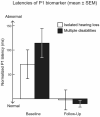Auditory Cortex Maturation and Language Development in Children with Hearing Loss and Additional Disabilities
- PMID: 38002904
- PMCID: PMC10670362
- DOI: 10.3390/children10111813
Auditory Cortex Maturation and Language Development in Children with Hearing Loss and Additional Disabilities
Abstract
A significant portion of hearing-impaired children have additional disabilities, but data about the maturation of their auditory cortex are scarce. In these children, behavioral tests are often unreliable, and objective tests are needed for diagnostics and follow-up. This study aimed to explore auditory cortical maturation and language development, and the usability of an objective electroencephalogram-based biomarker in children with multiple disabilities. In 65 hearing aid and cochlear implant users (36 females; 36 with multiple disabilities; 44.3 ± 18.5 months of age, mean ± SD), auditory processing was examined using the P1 cortical auditory evoked response biomarker, and language development with the Preschool Language Scales 5th edition (PLS-5). During the study, all of the children received intensive extra language therapy for six months. No significant differences were found between the groups in P1 latency development, the proportion of abnormal P1 latencies, or the number of children whose P1 latencies changed from abnormal to normal during the study. The PLS-5 total language scores, auditory comprehension scores, or expressive communication scores did not differ between groups either. The P1 latencies showed meaningful negative correlations with the language scores. The results suggest that auditory cortex development is similar in hearing-impaired children with/without additional disabilities, and the P1 biomarker is a feasible tool to evaluate central auditory maturation in children with multiple disabilities.
Keywords: CAEP; EEG; P1 biomarker; auditory; cortical; disability; electroencephalogram; evoked potential; hearing loss; language.
Conflict of interest statement
The authors declare no conflict of interest.
Figures




References
-
- Home—OMIM. [(accessed on 1 October 2023)]. Available online: https://www.omim.org/
-
- Shearer A.E., Hildebrand M.S., Schaefer A.M., Smith R.J. Genetic Hearing Loss Overview. In: Adam M.P., Mirzaa G.M., Pagon R.A., Wallace S.E., Bean L.J., Gripp K.W., Amemiya A., editors. GeneReviews®. University of Washington; Seattle, WA, USA: 1993. [(accessed on 1 October 2023)]. Available online: http://www.ncbi.nlm.nih.gov/books/NBK1434/
-
- Cupples L., Ching T.Y.C., Button L., Leigh G., Marnane V., Whitfield J., Gunnourie M., Martin L. Language and speech outcomes of children with hearing loss and additional disabilities: Identifying the variables that influence performance at five years of age. Int. J. Audiol. 2018;57((Suppl. S2)):S93–S104. doi: 10.1080/14992027.2016.1228127. - DOI - PMC - PubMed
Grants and funding
LinkOut - more resources
Full Text Sources

